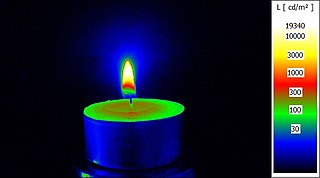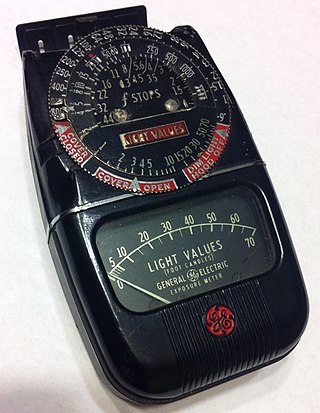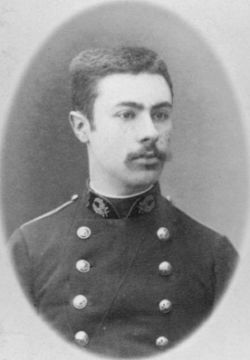Related Research Articles

The candela is the unit of luminous intensity in the International System of Units (SI). It measures luminous power per unit solid angle emitted by a light source in a particular direction. Luminous intensity is analogous to radiant intensity, but instead of simply adding up the contributions of every wavelength of light in the source's spectrum, the contribution of each wavelength is weighted by the standard luminosity function. A common wax candle emits light with a luminous intensity of roughly one candela. If emission in some directions is blocked by an opaque barrier, the emission would still be approximately one candela in the directions that are not obscured.

Luminance is a photometric measure of the luminous intensity per unit area of light travelling in a given direction. It describes the amount of light that passes through, is emitted from, or is reflected from a particular area, and falls within a given solid angle.
The International System of Units, known by the international abbreviation SI in all languages and sometimes pleonastically as the SI system, is the modern form of the metric system and the world's most widely used system of measurement. Established and maintained by the General Conference on Weights and Measures (CGPM), it is the only system of measurement with an official status in nearly every country in the world, employed in science, technology, industry, and everyday commerce.

The metric system is a system of measurement that succeeded the decimalised system based on the metre that had been introduced in France in the 1790s. The historical development of these systems culminated in the definition of the International System of Units (SI) in the mid-20th century, under the oversight of an international standards body. Adopting the metric system is known as metrication.
The candela per square metre is the unit of luminance in the International System of Units (SI). The unit is based on the candela, the SI unit of luminous intensity, and the square metre, the SI unit of area. The nit is a non-SI name also used for this unit. The term nit is believed to come from the Latin word nitēre, "to shine".

The lux is the unit of illuminance, or luminous flux per unit area, in the International System of Units (SI). It is equal to one lumen per square metre. In photometry, this is used as a measure of the intensity, as perceived by the human eye, of light that hits or passes through a surface. It is analogous to the radiometric unit watt per square metre, but with the power at each wavelength weighted according to the luminosity function, a standardized model of human visual brightness perception. In English, "lux" is used as both the singular and plural form.
In photometry, luminous intensity is a measure of the wavelength-weighted power emitted by a light source in a particular direction per unit solid angle, based on the luminosity function, a standardized model of the sensitivity of the human eye. The SI unit of luminous intensity is the candela (cd), an SI base unit.

Photometry is the science of the measurement of light, in terms of its perceived brightness to the human eye. It is distinct from radiometry, which is the science of measurement of radiant energy in terms of absolute power. In modern photometry, the radiant power at each wavelength is weighted by a luminosity function that models human brightness sensitivity. Typically, this weighting function is the photopic sensitivity function, although the scotopic function or other functions may also be applied in the same way.

A foot-candle is a non-SI unit of illuminance or light intensity. The foot-candle is defined as one lumen per square foot. This unit is commonly used in lighting layouts in parts of the world where United States customary units are used, mainly the United States. Nearly all of the world uses the corresponding SI derived unit lux, defined as one lumen per square meter.

In photometry, luminous flux or luminous power is the measure of the perceived power of light. It differs from radiant flux, the measure of the total power of electromagnetic radiation, in that luminous flux is adjusted to reflect the varying sensitivity of the human eye to different wavelengths of light.

In photometry, illuminance is the total luminous flux incident on a surface, per unit area. It is a measure of how much the incident light illuminates the surface, wavelength-weighted by the luminosity function to correlate with human brightness perception. Similarly, luminous emittance is the luminous flux per unit area emitted from a surface. Luminous emittance is also known as luminous exitance.
A phot (ph) is a photometric unit of illuminance, or luminous flux through an area. It is not an SI unit but rather is associated with the older centimetre–gram–second system of units. The name was coined by André Blondel in 1921.

Candlepower is a unit of measurement for luminous intensity. It expresses levels of light intensity relative to the light emitted by a candle of specific size and constituents. The historical candlepower is equal to 0.981 candelas. In modern usage, candlepower is sometimes used as a synonym for candela.
The lumen is the unit of luminous flux, a measure of the total quantity of visible light emitted by a source per unit of time, in the International System of Units (SI). Luminous flux differs from power in that radiant flux includes all electromagnetic waves emitted, while luminous flux is weighted according to a model of the human eye's sensitivity to various wavelengths. One lux is one lumen per square metre.
A foot-lambert or footlambert is a unit of luminance in United States customary units and some other unit systems. A foot-lambert equals 1/π or 0.3183 candela per square foot, or 3.426 candela per square meter. The foot-lambert is named after Johann Heinrich Lambert (1728–1777), a Swiss-German mathematician, physicist and astronomer. It is rarely used by electrical and lighting engineers, who prefer the candela per square foot or candela per square meter units.
In photometry, the lumen second (lm⋅s) is the unit of luminous energy in the International System of Units (SI). It is based on the lumen, the SI unit of luminous flux, and the second, the SI base unit of time.
The lambert is a non-SI metric unit of luminance named for Johann Heinrich Lambert (1728–1777), a Swiss mathematician, physicist and astronomer. A related unit of luminance, the foot-lambert, is used in the lighting, cinema and flight simulation industries. The SI unit is the candela per square metre (cd/m2).

André-Eugène Blondel was a French engineer and physicist. He is the inventor of the electromechanical oscillograph and a system of photometric units of measurement.
The apostilb is an obsolete unit of luminance. The SI unit of luminance is the candela per square metre (cd/m2). In 1942 Parry Moon proposed to rename the apostilb the blondel, after the French physicist André Blondel. The symbol for the apostilb is asb.
The bril is an old, non-SI, unit of luminance. The SI unit of luminance is the candela per square metre.
References
- ↑ Parry Moon. "System of photometer concepts", in the Journal of the Optical Society of America, volume 32, number 6 (June 1942). – Page 355: "The lumen was proposed by Blondel in 1894 and is now universally accepted. The names, phot and stilb were likewise coined by Blondel (1921) and are in general use on the Continent."
- ↑ American Standard Definitions of Electrical Terms, New York: American Institute of Electrical Engineers, 1941.
- ↑ IEEE/ASTM SI 10-2002. American National Standard for Use of the International System of Units (SI): The Modern Metric System. New York: IEEE, 30 December 2002. See Section 3.3.3.